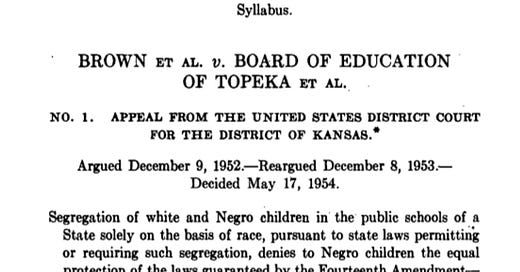When the Trump administration stripped anti-segregation language from federal contracting rules, it didn’t make enough headlines. Yet the change—a repeal of protections dating back to President Lyndon B. Johnson’s Executive Order 11246—signaled something deeply consequential: the federal government quietly walking away from a basic commitment not to do business with Jim Crow.
The clause, enforced for decades by the General Services Administration (GSA), explicitly banned federal contractors from operating segregated facilities—waiting rooms, bathrooms, cafeterias. Its removal set off alarms among civil rights attorneys. But over on Black Twitter, the reaction was more nuanced, even jaded. Some expressed nostalgia for the Jim Crow era—not for the oppression, but for the clarity it offered. At least, they reasoned, we knew where we stood.
Segregation by Force, Not by Choice
Let’s be clear: ADOS (American Descendants of Slavery) have always yearned for sovereignty, not separation for its own sake. The idea that we’d be better off living apart isn’t new. It’s a fantasy born of desperation, but we must remember—during segregation, we didn’t control our communities. We were confined to them. These were not autonomous enclaves built by choice; they were racial redlined zones backed by law and violence.
Desegregation wasn’t about seeking proximity to white folks. It was about escaping the trap. It was about freedom of movement, freedom of opportunity, and the right to choose our own path.
What Brown v. Board Didn’t Understand
In an episode of Revisionist History titled “Miss Buchanan’s Period of Adjustment,” Malcolm Gladwell lays it bare: The fight for desegregation was never about white schools being “better.” It was about power—access to resources, institutions, and networks from which ADOS had long been excluded.
Yet the Supreme Court’s ruling in Brown v. Board of Education misframed the problem. Rather than focusing on structural inequality, the justices leaned on the idea that separation itself was psychologically damaging to ADOS children.
From the Brown v Board decision:
“To separate them from others of similar age and qualifications solely because of their race generates a feeling of inferiority as to their status in the community that may affect their -hearts and minds in a way unlikely ever to be undone.”
But that wasn't what the Brown family fought for. And it certainly wasn't a blueprint for liberation. Because the Browns had no problem with their child’s all Negro school, except that it was far away & forced their daughter to walk through busy streets to get there. They loved their Negro school. They didn’t love its location. And they didn’t feel that the white school had the right to tell them that their daughter was excluded from a closer school because of her race.
Gladwell imagined if the Court had ruled this way instead:
“Schools are where social power and opportunity reside. You cannot lock Black Americans out of those spaces and still call this country free.”
That would’ve mandated inclusion with choice. Not coerced integration. Not the closure of ADOS schools. Not the mass firing of ADOS teachers. Not the displacement of ADOS students into hostile white classrooms.
But that’s exactly what happened.
When Desegregation Became Displacement
What followed the Brown ruling wasn’t a celebration of civil rights. It was a quiet purge. In cities across the South, ADOS schools were shuttered. ADOS principals and teachers were dismissed en masse. Black students were thrown into unfamiliar environments where they were often criminalized, ignored, underestimated or outright abused.
In Prince Edward County, Virginia, white officials closed the entire public school system for five years rather than integrate. Thousands of ADOS children were left without education, while white children attended private segregation academies funded by public dollars.
This wasn’t integration. It was sabotage.
The New Language of Old Oppression
Now, in 2025, we're watching history whisper through policy again. When the Trump administration repealed Johnson’s executive order protections, they didn’t need to hold a press conference. They knew most people wouldn’t notice. That’s how racial regression works now—quietly, bureaucratically, under cover of “deregulation.”
But don’t get confused. This isn’t about administrative efficiency. It’s about removing the last legal barriers that stand between ADOS and the return of state-sanctioned apartheid.
This moment demands that we say clearly: Forced segregation was wrong. But so was the way desegregation was implemented.
What We Need Now: Choice, Power, and Repair
I’ve seen too many of us lured into a false debate. This isn’t about whether Jim Crow had some secret benefit. It's about telling the truth: Neither segregation nor desegregation ever prioritized ADOS agency. Both were orchestrated by systems that saw us as a problem to be managed—not a people to be empowered.
We don’t want to return to the past. But we do want the truth about the past. And we want justice rooted in that truth.
We want schools that reflect our culture, led by teachers who understand our lineage.
We want policies that protect our autonomy, not just shuffle us into hostile institutions.
And we want reparations—because the destruction of ADOS schools, ADOS educators, and the ADOS community’s institutions wasn’t just a historical mistake. It was a theft.
We are not asking to be included in someone else’s story. We’re demanding the right to write our own.





I don't disagree with your expressed perspectives. I do take issue with the title. As it relates to education and the community around the schools, those of us who view those times more favorably than what our grandchildren live, boils down to educational outcomes. Be it me who grew up in 3rd Ward Houston,TX or my 13 year older husband who grew up in Horando, MS, our educational outcomes were exponentially better. We have no "yearning" for return of Jim Crow but for ADOS to continue the fight for us to be free as opposed to just freed and without massive numbers our our children as causalities.